Advance Journal of Food Science and Technology
Effect of Duration and Temperature of Fermentation on Black Garlic Properties
Advance Journal of Food Science and Technology 2019 17: 86-93
Cite This ArticleAbstract
This study aimed to investigate the effects of temperature and duration of fermentation on black garlic properties. The moisture content, lightness, total reducing sugar, proteins content, total polyphenols, antioxidant activity and DPPH radical scavenging activity, were determined. The experimental Design used in this study were Factorial Completely Randomized Design. The factors were, factors 1 = fermentation temperature variations (60; 70; and 80°C) and factors 2 = fermentation time variation (7; 14; and 21 days) each treatment repeated 3 (three times). The results of this study show that temperature and duration of fermentation have significant effect on the physical, chemical and bioactive properties of black garlic. The increase of duration and temperature of fermentation process in black garlic production increase the level of reducing sugar, protein content, total polyphenols, antioxidant activity and reduce the lightness and moisture content of black garlic.
Keywords:
Introduction
Since long ago, garlic (Allium sativum L.) has been widely used for spices and believed to have several benefits for the treatment of Hypercholesterolemia. Hypercholesterolemia is an increase in the level of cholesterol in the blood or can be accompanied by an increase in levels of Low Density Lipoprotein (LDL). This condition can increase the risk of atherosclerosis and stimulate various other diseases, such as hypertension, diabetes mellitus and cardiovascular disease (Kopin, 2010).
The results of in vitro and in vivo studies have confirmed that garlic show antidiabetic, antihypertensive, anticholesterol, antiatherosclerosis, antioxidant, antiplatelet cell aggregation, fibrinolysis booster, antivirus, antimicrobial and anticancer properties (Lu et al., 2016). The effectiveness of garlic in overcoming hypercholesterolemia has proved from many studies (Stevinson et al., 2000; Yeh et al., 2001; Iweala et al., 2005; Gebreyohannes and Gebreyohannes, 2013). In order to have a lot of health potential, garlic should be consumed raw (without processing) in large quantities, other than as spices, but unfortunately garlic has an adverse effect due to the less pleasant characteristics of the aroma and spicy taste and induce to stomach pain for those who consume it (Bae et al., 2014).
Bae et al. (2014) reported that fermentation at high temperature can eliminate unpleasant aroma and spicy taste of fresh garlic. The fermentation treatment carried out at temperatures (60-80°C) can eliminate such unwanted characteristics and increase the palatability of garlic (Garcia-Villalon et al., 2016).
Garlic which is processed using high temperature fermentation is called black garlic. Garlic which is processed into black garlic experiences various kinds of physical, chemical and sensory changed (color, taste and aroma) (Kimura et al., 2017). The color of the garlic bulb turns to black, the taste changes more sour with the sweetness and the texture of this product is like jelly (Bae et al., 2014). During fermentation process, there are organosulfur components such as S-allylsistein (SAC), SAC provides cardioprotective effects and antioxidant activity (Garcia-Villalon et al., 2016).
The study of Lee (2009) proved that the antioxidant TEAC value of garlic and black garlic was 13.3±0.5 and 59.2±0.8 µmol/g wb. Black garlic has stronger antioxidant activity than garlic so that it can be used to prevent increases in LDL levels in the blood. According to Bae et al. (2014), the longer time for black garlic fermentation will increase the content of S-allycysteine (SAC), with the presence of higher antibacterial compounds, so black garlic expected to be more effective in treating disease causes by pathogenic prokaryotic.
The black garlic potential has not been widely developed in Indonesia and there are no standardization of the black garlic production process, such as optimal temperature and time in fermentation process which can increase the yield of black garlic both in quality and quantity. The use of various temperatures and fermentation times can produce black garlic with diverse physical, chemical and bioactive characteristics. This research aims to determine the effect of temperature and duration of fermentation on the physical, chemical and bioactive properties of black garlic produced.
Materials And Methods
Materials and research sites: Garlic used as material in this research is a type of Shin-chung obtained from Tanjung Market of Jember. The research was conducted at several laboratories in University of Jember (Laboratory of Agricultural Product Engineering, Chemistry and Biochemistry, C-DAS and Integrated Quality), in Polytechnic of Jember (Laboratory of BIOSAIN) and Gajah Mada University (LPPT, PAU Food and Nutrition).
Research design: The experimental design used in this study was Factorial Completely Randomized Design, with two factors. That are temperature of fermentation (60; 70; and 80°C) and duration of fermentation (7; 14; and 21 days) each treatment repeated 3 (three) times. The A factor temperature and B factor is duration.
A1 = 60°C B1 = 7 days
A2 = 70°C B2 = 14 days
A3 = 80°C B3 = 21 days
The Combination of these factors is as follow:
| A1B1 | A2B1 | A3B1 |
| A1B2 | A2B2 | A3B2 |
| A1B3 | A2B3 | A3B3 |
The observer parameters are lightness (color), moisture content, total reducing sugars and proteins content, total polyphenols and antioxidant activity. The data obtained were analyzed by analysis of variance with 95% confidence level and continued with DMRT (Duncan Multiple Range Test)
Results And Discussion
Lightness of black garlic: Lightness is one of the parameters of the quality of food products to be liked by consumers. Changes that occur in the color of food products are often used as one of the parameters for changing the physical and chemical properties of the product. In this study, color observations were made on changing the color lightness of each study treatment. The value of color lighness ranges from 0-100.
Based on the research, the average value of color lightness of black garlic products at various temperatures and fermentation times ranged from 28.48-59.37. Based on variance analysis with a confidence interval of 95%, showed that the fermentation temperature had a significant effect on the lightness of the black garlic color, while the duration of fermentation and the interaction of both had no significant effect on the lightness of the black garlic color. The effect of fermentation temperature on the lightness value of black garlic color can be seen in Fig. 1 and the color change of black garlic during fermentation can be seen in Fig. 2.
Based on Fig. 1 and DNMRT test (Duncan, s New Multiple Range Test), it can be seen that, increasing the fermentation temperature would decreased the lightness value of the black garlic produced. At a fermentation temperature of 60°C the lightness value of black garlic color was 51.05, significantly different from the lightness value of black garlic color at 70°C (31.85) and 80°C (32.56), while the lightness value of black garlic at 70°C and 80°C statistically the same. The maillard reaction occurs between a reduced carbonyl sugar group with an amino group and forms an amadory component (non-enzymatic browning reaction). According to Nursten (2005) states that at the initial stage the maillard reaction produces a yellow product through several reactions such as dehydration sugar, sugar fragmentation and amino acid degradation (Strecker degradation). In the last stage the maillard reaction is caused by aldol condensation, aldehyde-amine condensation and the formation of heterocyclic nitro compounds, so the black garlic color became black (Billaud et al., 2004). According to Bae et al. (2014) the intensity of brownish color continued to increase at the temperature of 85°C, but the sample of garlic heated at a temperature of 70°C browned intensity reached the same level as the sample heated 85°C. As long as the process of changing the color of garlic to black was related to the temperature that causes a non-enzymatic browning reaction or the reaction of maillard, this color change is due to the formation of melanoidin compounds during the maillard reaction process (Kang, 2016).
Moisture content of black garlic: Water content is very determines on the quality of food, because water can affect the appearance, hardness and taste of food. In black garlic products, water content is very influential on the black garlic hardness produced. Based on research, the average value of water content of black garlic products at various temperatures and fermentation times ranged from 20.69-67.18%. Based on variance analysis with a confidence interval of 95%, indicate that the temperature and duration of fermentation, as well as the interaction between the two have a significant effect on the water content of black garlic. The effect of temperature and duration of fermentation on the value of black garlic water content can be seen in Fig. 3.
Based on Fig. 3 and DNMRT test (Duncan, s New Multiple Range Test), it can be seen that, increasing the fermentation temperature would increase the water content of black garlic, then higher temperatures would reduce the water content of the black garlic produced. While longer fermentation time would reduce the water content of black garlic. From the results of this study it was found that the highest moisture content was black garlic which was processed at 70°C and fermented for 14 days (67.18%) and the lowest water content of black garlic which was processed at 80°C for 21 days.
The heat fermentation process is carried out on garlic bulbs with high temperature and high humidity (Kimura et al., 2017), the heating process of polysaccharide degradation into simple sugars, which is followed by the softening of the black garlic texture and increasing water content (Yuan et al., 2016). The increase in fermentation time it will reduce the water content from the black garlic, because longer the fermentation time causes more water evaporation so that the water content in the material gets smaller. Evaporation is also caused by the difference in vapor pressure between water in the material and water vapor in the air. The pressure of water vapor in the material is generally greater than the pressure of water vapor in the air so that there is a mass transfer of water from the material into the air. According to Ratnasari (2014) explained that water evaporates through the surface of the material while the water in the middle seeps to the surface and then evaporates. To speed up drying, generally the material will be cut or mashed. This is related to the surface area of the material where the wider the surface of the material, the greater the surface that was in direct contact with heat, thus accelerating the evaporation process that occurs.
Protein content of black garlic: Protein is of the elements nutrition as a source of amino acids that contain elements C, H, O and N. Protein content in food ingredients will affect the quality and characteristics of these food products. Based on the research, the average value of protein content of black garlic products at various temperatures and fermentation times ranged from 6.42-6.89%. Based on variance analysis with a confidence interval of 95%, showed that the temperature and duration of fermentation significantly affected the water content of black garlic. Where both interactions done not have a significant effect on the level of black garlic protein. The effect of temperature and duration of fermentation on the average value of black garlic protein levels can be seen in Fig. 4a and 4b.
Based on Fig. 4a and 4b the DNMRT test (Duncan, s New Multiple Range Test), it can be seen that the increase in temperature and duration of fermentation would increase the protein content of black garlic, this is because the higher the temperature and the longer the fermentation process would reduce the water content of the black garlic produced. The lower water content in a material technically would increase the other nutrient content, in this case the protein content. According to Ratnasari (2014) stated that the process of heating the material, the higher temperature and the longer time to heat would accelerate the decrease in water content of a material. From the results of this study it was found that the highest protein content was black garlic which was processed at 80°C and the duration of fermentation was 21 and black garlic was the lowest protein content that was processed at 60°C for 7 days.
During the aging process there was a maillard reaction which caused a characteristic change and an increase in several bioactive compounds such as S-Allyl Cysteine (SAC), amino acids, flavonoids and polyphenols in black garlic. Based on research from Sasaki et al. (2007) that the protein content of black garlic was greater than fresh garlic as much as 8.1%, to 9.1% with a treatment of 70°C for 30-40 days. The same thing reported by Nassur et al. (2017) said that the amount of black garlic protein was greater than garlic which is 10.62% to 11.75%. The initial hypothesis of the maillard reaction can consume amino acids, so the protein content of black garlic is lower, but this was not proven in the study. Increased amino acid content including aspartate acid, threonine, arginine and leucine, are most likely caused by degradation of proteins or peptides, which may result from enzymatic hydrolysis or non-enzymatic hydrolysis, such as pyrolysis (Liang et al., 2015). In addition, a low pH of black garlic made it possible to cause further enzymatic hydrolysis of proteins under acidic conditions, namely, where the highest acidic conditions occur at 700 C and RH 60% for 60 h-750 C and RH 70% for 48 h (Kang, 2016).
Reducing sugar of black garlic: Reducing sugar is which has the ability to reduce compounds such as glucose and fructose. The capability to reducing sugars is caused by the presence of free aldehyde or ketones. All monoscharides (glucose, fructose, galactose) and disaccharides (lactose, maltose) except sucrose and starch (polysaccharides) are included as sugar reducer. Based on the research, the average value of the reduced sugar content of black garlic products at various temperatures and fermentation times ranged from 3.68-4.80%. Based on variance analysis with a confidence interval of 95%, showed that the temperature and duration of fermentation, as well as the interaction of both of them had a significant effect to reduced sugar content of black garlic. The effect of temperature and duration of fermentation on the average value of reducing sugar content of black garlic can be seen in Fig. 5.
Based on Fig. 5 and DNMRT test (Duncan, s New Multiple Range Test), it can be seen that, increasing temperature and duration of fermentation would increase the reducing sugar content of black garlic. This can be caused by two factors, during the fermentation process, the first factor is Polysaccharide in garlic was degraded into reducing sugar and the second factor is reducing sugars consumed during the non-enzymatic browning process (maillard reaction). Degraded polysaccharides into simple sugar compounds thus increasing the reducing sugar content of fermented garlic, according to Choi et al. (2014) there was an increasing in sugar levels such as glucose, fructose, sucrose and maltose in the garlic fermentation process, the main polysaccharide on the garlic will be degraded continuously and increase the monosaccharide at the same time. According to Yuan et al. (2016) black garlic had a high concentration of water soluble sugar rather than fresh garlic, namely fructose, glucose and sucrose. Fructan and hydrolase can interact to hydrolyze fructan into glucose and fructose during the thermal process, glucose and fructose from fructans which can then react with the main amino acids in garlic.
Based on the research of Zhang et al. (2015) that reducing sugar levels experienced an increasing in samples heated at temperatures of 60°C and 70°C, reducing sugar levels increased tremendously in the early stages 80°C to 21 days and decreased after 21 days. The maillard rate and caramellization reaction increase at high temperatures, so the consumption level of reducing sugar exceeds the accumulation rate. As a result, reducing sugar levels show a downward trend at a later stage at high temperatures. Black garlic with a temperature treatment of 70°C had a very high amount of reducing sugar accumulation, relative to sweetness when over 15 days and would continue to increase during fermentation.
Polyphenols content of black garlic: Polyphenol is one of the important factors that responsible for the antioxidant activity of garlic (Prasonto et al., 2017), the polyphenols content of analisys polyphenols is expressed as Garllic Acid Equivalent (GAE), in percent. The black garlic fermentation process has a considerable influence on changing the phenolic components in the test material. Based on the research, the average value of the total polyphenols of black garlic products at various temperatures and fermentation times ranged from 0.16-1.73%. Based on variance analysis with a confidence interval of 95%, showed that the temperature and duration of fermentation, as well as the interaction between them significantly affected the total levels of black garlic polyphenols. The effect of temperature and duration of fermentation on the average value of black garlic polyphenols can be seen in Fig. 6.
Based on Fig. 6 and DNMRT test (Duncan, s New Multiple Range Test), it can be seen that the determined in temperature and duration of fermentation would increase the total polyphenol levels of black garlic. The increase in the total value of polyphenols is due to the maillard process during fermentation of garlic, with heat increasing the release of phytochemical components from cell matrices such as phenolic acids (Utami et al., 2017), the thermal process made the cell wall and cell membrane weaken thereby releasing dissolved phenolic components from Bonds of esters and glycosides become free fractions of phenol acid (Kim et al., 2017).
Total polyphenols are one of the important indicators to determine the quality of black garlic (Xiong et al., 2018). The condition of processing garlic gave a change in its bioactive components, increasing levels of polyphenols in garlic processed into black garlic shows the level of accumulation of phenol formation exceeds consumption level its phenolic compounds (Zhang et al., 2015), with the longer fermentation process made consumption exceed the accumulation of its formation. According to Zilic et al. (2013) with increasing heating time it gave a higher temperature load, which can significantly decreases phenolic acid in the material from the beginning of heating. According to Choi et al. (2014), the total polyphenols increased during heat treatment and experienced a significant increase to 21 days, but after that it decreased as the heating process continued. The increase in temperature will increase the permeability of the cell wall and result in an increase in solubility and diffusion of extracted phenolic compounds. An increase in temperature also caused an increase in the total phenol level to a certain temperature, but as the temperature increases it will cause a decrease in phenolic compounds. This is because the decomposition of phenolic compounds that cause boiling points of new compounds is more volatile (Escribano-Bailon and Santos-Buelga, 2003).
Antioxidant activity of black garlic: Antioxidants are molecules that are able to slow down or prevent the oxidation of other molecules (Schuler, 1990). Oxidation was a chemical reaction that can produce free radicals, which triggers a chain reaction that can damage cells. Antioxidants such as ascorbic acid end this chain reaction. To maintain a balance of oxidation levels, plants and animals have a complex system of antioxidants, such as glutathione and enzymes (for example: catalase and superoxide dismutase) which are produced internally or can be obtained from the intake of vitamin C, vitamin A and vitamin E.
Antioxidants can significantly slow down or inhibit oxidation of substances that are easily oxidized even in low concentrations (Halliwel et al., 1995). Antioxidants are also suitably defined as compounds that protect cells from the harmful effects of reactive oxygen free radicals if they are related to disease, these free radicals can be derived from metabolism or other external factors (Halliwel et al., 1995). Free radicals were species that are not stable because they have unpaired electrons and look for electron pairs in biological macromolecules (Subeki, 1998). Lipid proteins and DNA from healthy human cells are good sources of electron pairs. Oxidation conditions can cause damage to proteins and DNA, cancer, aging and other diseases (Maxwell, 1995). The chemical components that act as antioxidants are phenolic and polyphenolic compounds. These group compounds are widely available in nature, especially in plants and have the ability to capture free radicals (Ramle et al., 2008). Antioxidants were found in many foods, including vitamin E, vitamin C and carotenoids (Halliwel et al., 1995).
Based on research carried out the average value of antioxidant activity of black garlic products at various temperatures and fermentation times ranged from 62.95 to 79.01%. Based on variance analysis with a confidence interval of 95%, indicated that the temperature and duration of fermentation, as well as the interaction of both had a significant effect on the antioxidant activity of black garlic. The effect of temperature and duration of fermentation on the average black garlic antioxidant activity can be seen in Fig. 7.
Based on Fig. 7 and DNMRT test (Duncan, s New Multiple Range Test), it can be seen that, increasing temperature and length of fermentation time would increase the antioxidant activity of black garlic. In the treatment of fermentation temperature of 60°C and duration of fermentation of 7 days antioxidant activity was 63.17%, significantly higher than raw garlic 35.28% (Choi et al., 2014), DPPH free radical activity of black garlic increased by approximately 79%, while at 80°C fermentation temperature and 21 days fermentation time of 78.79%, there was an increasing in antioxidant activity from A1B1 treatment (temperature 60°C and 7 days fermentation time) to A3B3 (80°C temperature and 21 days fermentation time) of 25%. Antioxidant activity in black garlic has a linear relationship with the total content of black garlic polyphenols.
The total polyphenols content of black garlic was not only much higher than raw garlic or fermentation treatment at 60°C and fermentation time is 7 days, but also increases significantly until the length of fermentation day 21. According to Kim et al. (2013) this was due to hydroxycinamic acid derivatives and other phenolic acid content increasing more than 5-fold in black garlic garlic compared to raw garlic. This increase in phenolic acid may also be related to an increase in the total acid content of black garlic. According to Xu et al. (2007), heat during the fermentation process of black garlic phenolic compounds increased the fraction of free phenolic acid, but heat fermentation will reduce the fraction of esters, glycosides and esters-bound, which leads to an increase in the free phenol form. Gorinstein et al. (2008), showed that the processing conditions of black garlic caused changes in the total bioactive compounds, such as polyphenols, flavonoids and anthocyanin.
According to Choi et al. (2014) DPPH free radical inhibition activity from black garlic increased 2-fold on day 21 and then decreased slightly to day 35. DPPH free radical activation patterns from black garlic are similar to patterns of total polyphenol content. This was in accordance with Tsai et al. (2005) showed that there was a significant correlation between antioxidant activity and total phenolic content. According to Lu et al. (2016) there was a close relationship between total phenol content and DPPH radical inhibition rate. DPPH radical inhibition rate was highest about 30% at a concentration of 30 mg/mL, close to 5 mg/mL ascorbic acid or galat.
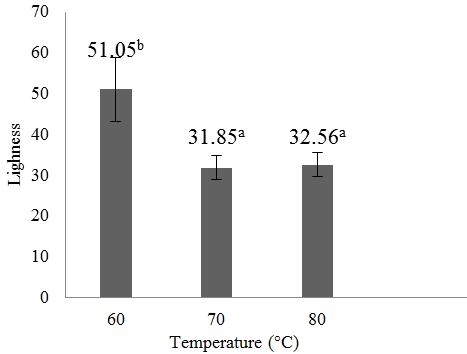
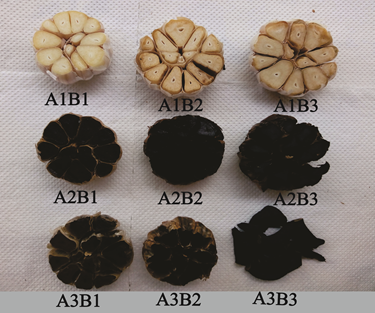
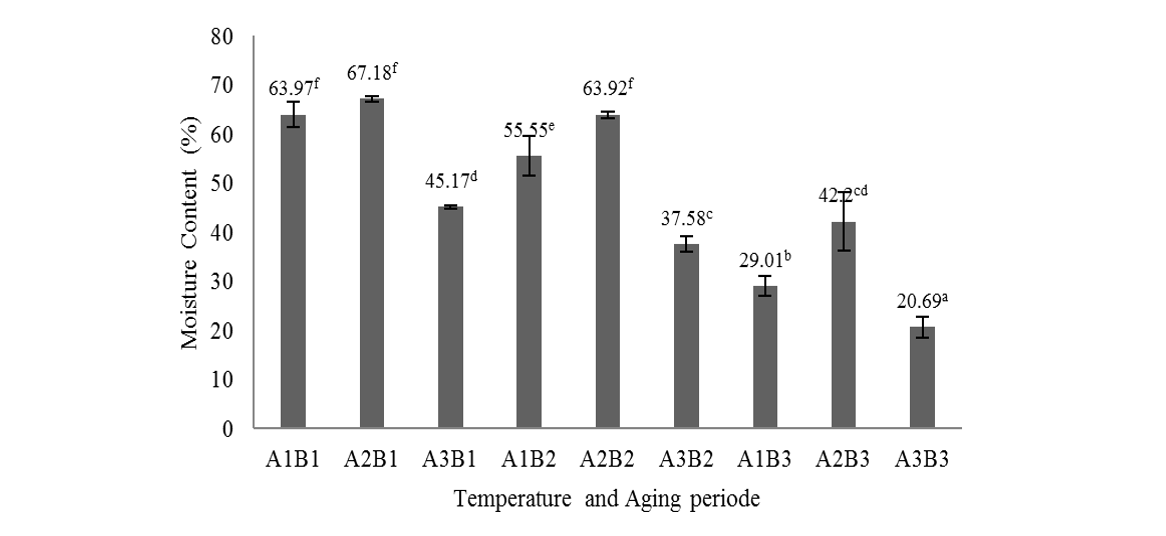
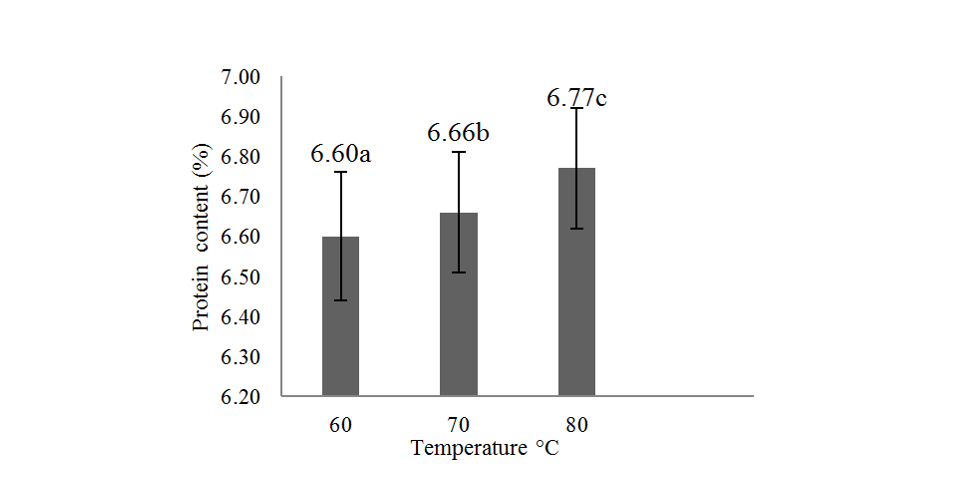
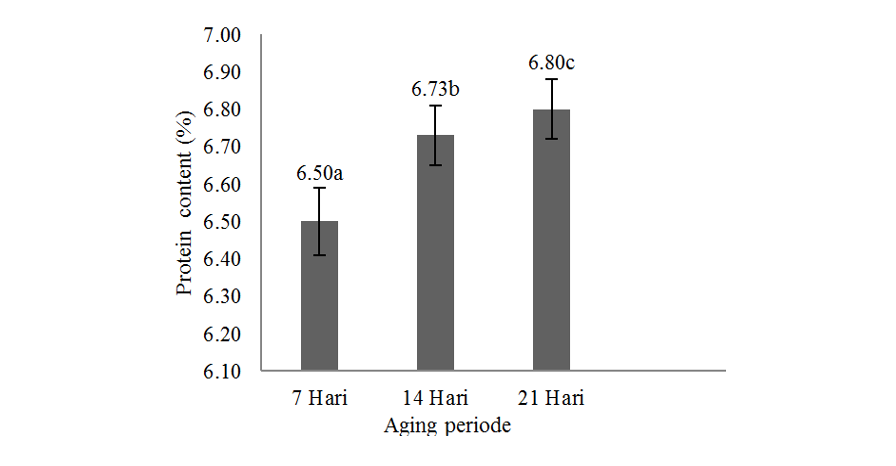
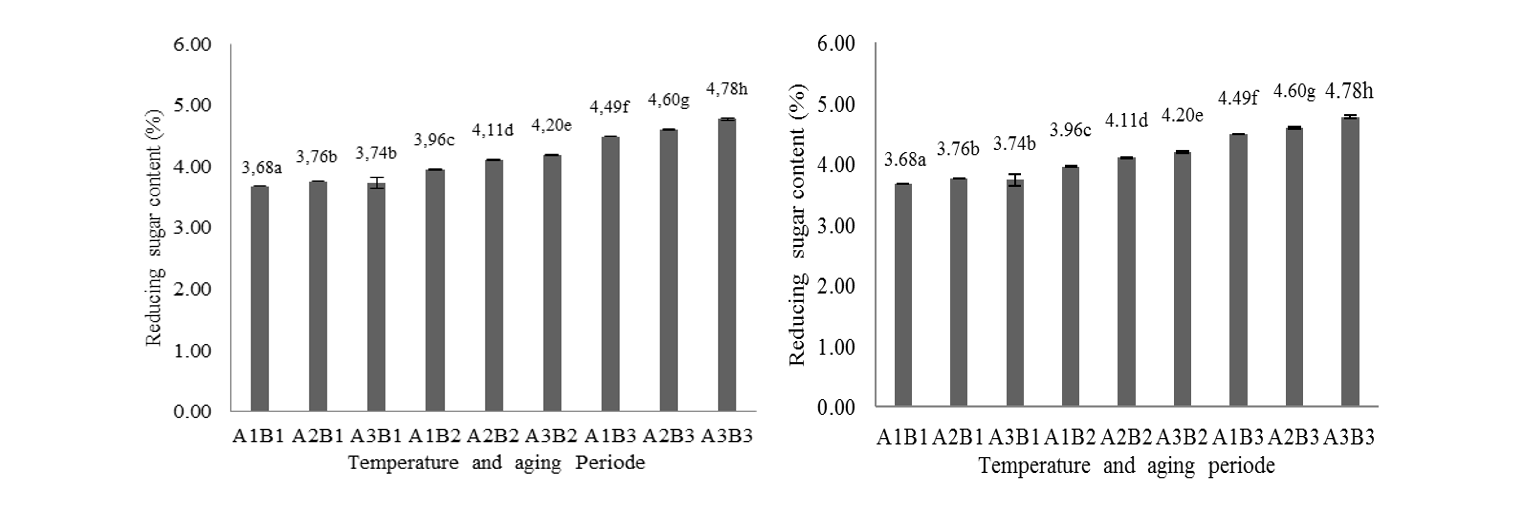
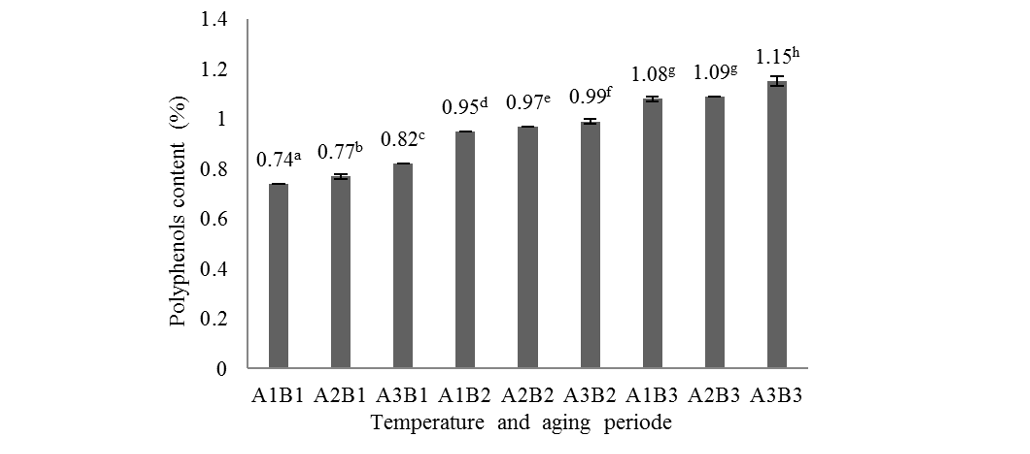
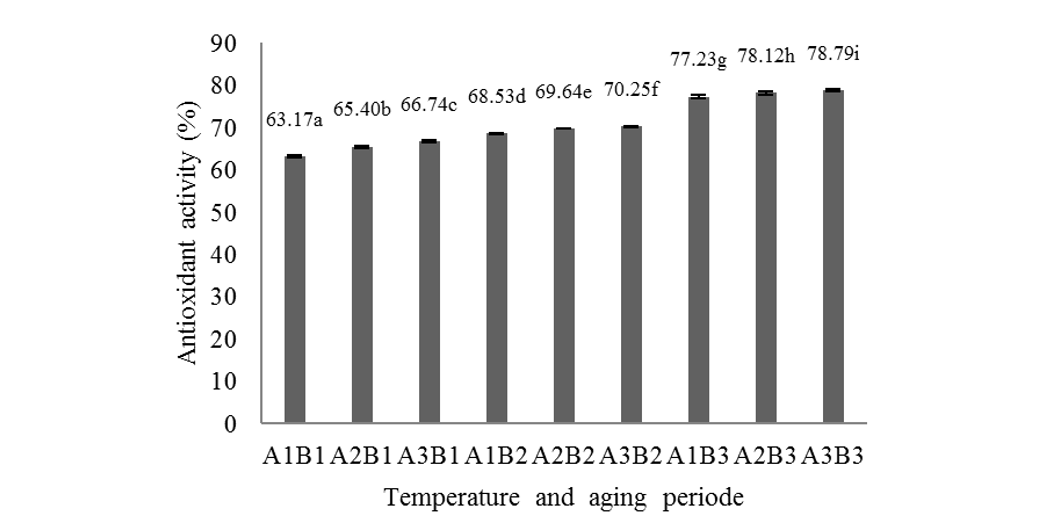
Conclusion
Based on the results of the study it can be concluded that: 1) The temperature and duration of fermentation had significant effect on the physical, chemical and bioactive properties of black garlic; 2) The increasing of temperature and duration of fermentation process will increase reducing sugar levels, protein content, total polyphenols, antioxidant activity, while the lightness and moisture content of black garlic decrease.
Author Details
1University of Jember, Faculty of Agricultural Technology, Department of Agricultural Product Technology,
2University of Jember, Faculty of Public Health, Department of Community Nutrition,
3University of Jember, Faculty of Agricultural Technology, Department of Agricultural Engineering, Kalimantan street. No. 37 Post Code No. 68121 Jember, East Java, Indonesia
References
Rights and permissions
Open Access: This article is licensed under a Creative Commons Attribution 4.0 International License, which permits use, sharing, adaptation, distribution and reproduction in any medium or format, as long as you give appropriate credit to the original author(s) and the source, provide a link to the Creative Commons license, and indicate if changes were made. The images or other third-party material in this article are included in the article’s Creative Commons license, unless indicated otherwise in a credit line to the material. If material is not included in the article’s Creative Commons license and your intended use is not permitted by statutory regulation or exceeds the permitted use, you will need to obtain permission directly from the copyright holder. To view a copy of this license, visit http://creativecommons.org/licenses/by/4.0/
Cite this Article
DOI: http://doi.org/10.19026/ajfst.17.6033
Sections
